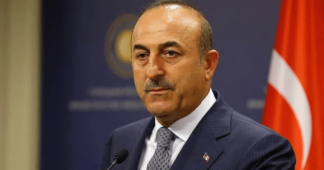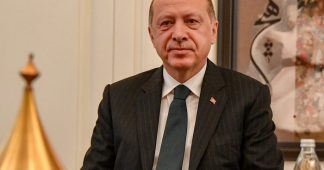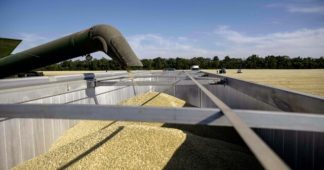Monthly situation report on Ukraine by Dmitri Kovalevich, July 31, 2023 (Dmitri Kovalevich is a special correspondent in Ukraine for Al Mayadeen English.
By Dmitri Kovalevich
Aug 3, 2023
July marks the one-and-a-half year anniversary of the start of the Russian Special Military Operation (SMO) in Ukraine. The key developments during the past month were Russia’s withdrawal from the agreement reached one year ago by each of Russia and Ukraine with Turkey and the UN for exports of grain from Ukraine, and the failure of the ‘counteroffensive’ launched nearly two months ago by the Armed Forces of Ukraine (AFU).
End of a grain export deal
On July 18, the Russian Federation announced it would not renew the agreement allowing for the export of grain from Ukraine through that country’s Black Sea ports. The ‘Black Sea Grain Initiative’ was an agreement reached by each of Russia and Kiev in July 2022 with Turkey and the United Nations, to last 120 days. It was renewed for an additional 120 days in November.
The Russian Ministry of Defense announced that as of midnight on July 20, all ships en route to Ukrainian ports in the Black Sea are considered as potential carriers of military cargo and therefore potentially involved in the conflict on the side of the Kiev regime.
The refusal by the Russian Federation to renew the agreement is caused by the fact that the conditions in the agreement allowing for the export of fertilizers and other agricultural products from Russia have not been respected and followed by the Western powers. They continue to threaten sanctions against countries purchasing Russian products. In addition, they continued to block the repair and reopening of the Tolyatti-to-Odessa ammonia pipeline [1], the world’s longest at nearly 2,500 km. It was ruptured by a bombing by Ukrainian saboteurs on June 5, 2023.
In addition, the Western cutoff of Russian financial institutions from the SWIFT system for international payments remains in place, meaning foreign buyers of Russian grain and any other products cannot easily pay.
Corporate and state media in the West have been scaring their readers with stories and headlines that the termination of the grain deal will cause a sharp rise in global food prices and a global food crisis. They seek to influence such hard-pressed countries as Yemen, Sudan, and Ethiopia by claiming that the actions of the Russian Federation may condemn the poorest people and countries on the planet to starvation. This is a blatant lie. Most of the grain exported from Ukraine during the past year was sold to traders in Turkey and Europe. Among its uses has been to feed pigs in Spain, in preparation for slaughter. Russia claims that only three percent of the grain has gone to the poorest countries.
Russian President Vladimir Putin published an essay in advance of the Russia-Africa Summit 2023 (in St. Petersburg on July 27-28). According to the data cited in the essay, more than 70 percent of Ukraine’s exports under the grain deal went to high-income countries, including the European Union. Less than three percent went to the world’s hardest-pressed countries, such as Ethiopia, Sudan, Somalia, Yemen and Afghanistan.
Putin wrote, “This ‘deal’, however, while it was publicly advertised by the West as a gesture of goodwill that benefited Africa, has in fact been shamelessly used solely for the enrichment of large U.S. and European businesses that exported and resold grain from Ukraine.”
Italian Defense Minister Guido Crosetto told an interview with the Italian newspaper La Stampa on July 21 that 95 percent of Ukrainian grain is going elsewhere than to Africa.
The International Monetary Fund is also concerned about the prospects for the grain deal and a possible reduction in grain sales by Ukrainian firms as this would reduce the capacity of the country to pay back its loans from international financial institutions such as the IMF itself. According to IMF calculations, if current bans on imports of Ukrainian grain by some countries in eastern Europe are extended (yes, some European ‘allies’ of Ukraine are banning food imports from it) and if the grain export deal is broken, this could lead to producer losses of over $800 million per month, about $10 billion per year.
Whither Ukraine and its agricultural industries?
As formerly one of the most industrially developed Soviet republics, Ukraine is reverting to becoming a primarily agrarian country, as it was 100 years ago when Soviet Ukraine was founded. Exports of grain and sunflowers now account for about half of all revenues to the public budget earned form exports. In fact, even before the start of the SMO, Ukraine’s economy was reverting to the model that had existed on its lands for thousands of years – rafting grain on river barges down to the Black Sea for sale while buying industrial products and weapons in return. Today’s Western ‘partners’ are, indeed, most interested in Ukraine as a supplier of cheap agricultural products for resale by Western giant agricultural firms to third countries. Ukrainian grain is now sold at a big discount.
During the one-year duration of the grain deal, Ukraine exported 50.6 million tons of grain worth $9.8 billion, according to a report in USA Today. (A different set of news reports speak of 32 million tons of grain worth $8–9 billion.)
Kiev would like to see NATO warships and especially Turkish warships off its shorelines to enforce a ‘grain deal’ on its own, exclusive terms. But the U.S. is advising Kiev to focus on overland grain export routes for now, that is, by road or rail to central and western to Europe.
Land exports are much more expensive and complicated for the Kiev regime to operate. The country’s railroads and highways cannot handle such an influx of cargo, especially as weapons, ammunition and humanitarian aid are flowing the other way and already clogging the routes. Furthermore, lack of maintenance over the years in ‘independent’ Ukraine (that is, post-Soviet Ukraine) of railways and roads looms large. In late July, one of the bridges over a mountain pass in Transcarpathia being used to transport agricultural products collapsed. The bridge collapsed not because of Russian shelling but because of the years of neglect of infrastructure by successive governments in Ukraine in the post-Soviet years.
Ukraine’s neighbors are clearly not happy about the proposals to increase overland exports. Cheap Ukrainian grain is supposed to go to ‘starving’ Third World countries. But thousands of tons have ended up in eastern European countries, depressing the prices that local farmers, already hard-pressed financially, might otherwise receive.
The government of Poland is ready to improve the transit of Ukrainian grain through its territory, but is demanding that the EU helps pay for infrastructure upkeep (and here). This is phrased as a demand for “solidarity” from the EU with Ukraine. All five EU countries that currently ban the sale (though not transport) of Ukrainian grain–Poland, Hungary, Slovakia, Romania, and Bulgaria—want the EU to help pay increased transport infrastructure costs.
An alternative grain shipping route?
On July 20, Ukraine informed the UN of its decision to seek an alternative route for grain shipments. Ukraine’s First Deputy Minister of Infrastructure Development Vasyl Shkurakov sent a letter to the UN’s International Maritime Organization saying that Ukraine has decided to create a temporary sea route for grain shipments after Russia’s withdrawal from the grain deal. According to the letter, it is planned to open shipping routes from the three inland ports of Izmail, Kiliya and Reni, located on the lower Danube, using smaller, ‘coaster’ vessels. These vessels would use a corridor through the inland and Black sea waters of Romania, a NATO member. Previously, grain was shipped along a corridor near to, but not through, the territorial waters of Black Sea states.
The three, proposed Danube ports have only been shelled in late July.
The disadvantage of this route is its low capacity. Bulk carriers of large tonnage cannot use it because the Danube River bottom is too shallow (app. seven meters draft). The U.S. recently promised Kiev that it would finance the dredging of the lower stretch of the river in the future, but this is unlikely until the conflict ends. What’s more, the proposal will have environmentalists up in arms because much of the Danube Delta remains untouched by industry and industrial shipping. This route is already being used for arms and ammunition shipments into Ukraine via NATO members Romania and Bulgaria.
The ending of the grain trade at the end of July was marked by massive rocket attacks by Russia against the ports of the Odessa region, which had not been shelled before. The Ukrainian Telegram channel ‘First. News of war‘ reports that “The recent attack on the ports of Odessa region near the border with Romania were aimed at destroying warehouses there filled with Western-supplied weapons. Recall that the Russian side has repeatedly accused the Western countries of using the ‘grain corridor’ to supply weapons, shells, and equipment to Ukraine. The recent large-scale attacks on the port and the subsequent explosions, visible on the shore from the Romanian side [some 50 km away], indicates that weapons were indeed being stored in the port’s grain terminals.”
Another reason for Russia’s withdrawal from the grain deal was Kiev’s use of the Black Sea to launch military attacks. In particular, on July 17, the bridge linking the Crimea peninsula to the Russian mainland was attacked. Naval drones launched from the Black Sea were used for this purpose.
This was the second such attack against the bridge. On July 26, the head of the Security Service of Ukraine (SBU), Vasyl Malyuk, admitted that the first attack against the bridge in October 2022 was the work of his agency. At the time, Zelensky had denied that Ukraine was behind that explosion, which killed five civilians. The words of the SBU head, then, actually prove that Zelensky lied.
Russia commits to supplying grain to the poorest countries
Since Ukrainian grain has hardly reached the poorest countries of Africa, the Russian Federation has promised to supply five of them with free grain while others will receive favorable prices. Russia has surplus grain production, but foreign buyers have difficulty in paying due to Western economic sanctions and strangulation. So one solution for Russia is to donate grain for humanitarian needs, especially since the Russian budget is much less dependent than Ukraine’s on revenues from grain exports.
In 2022, Russia harvested a record 158 million tons of grain, including 104 million tons of wheat. More than 55 million tons were exported. The Russian Ministry of Agriculture estimates the 2023 grain harvest at 123 million tons, including 78 million tons of wheat.
The head of the analytical department of the Russian Grain Union (RGU), Elena Tyurina, said in late July that even after the withdrawal from the grain deal, Russia was able to replace all the volumes of Ukrainian wheat for the countries in need. She also noted that the countries that bought Ukrainian wheat before the grain deal, including Egypt, Indonesia, Turkey, Pakistan, and Saudi Arabia, have now increased their purchases of Russian wheat.
Tyurina also noted that following last season’s successful results, Russia has significantly increased the volume of supplies to African countries, including Tanzania, Mozambique, Angola, South Africa, and Kenya. “We can even count African countries as our regular buyers. Of note is that this grain has been sold on a commercial basis. The exact quantities of grain that we will supply for free will be decided at a higher level.
“We have also displaced France on the Algerian market, increasing our deliveries there by 6.5 times. That is, we are getting stronger in the African market, very seriously so,” the specialist explains.
According to Russian media, Cuba is also considering the purchase of grain from the Rostov region of Russia. Cuba imported 43,700 tons of Russian products in the agricultural year 2021/2022, mostly in the form of wheat. In the first half of 2023, Russia has already exported 76,000 tons of wheat to Cuba. Meanwhile, Russia’s Leningrad region alone plans to export about 800,000 tons of grain to Africa.
No shortage of food production in the world, says analyst
Arkady Zlochevsky, president of the Russian Grain Union, says there should be no shortage of grain and food in the world. “A deficit is impossible in principle. The world has never experienced a shortage of food resources in relation to the level of consumption. There have always been surpluses. All the facts of hunger, malnutrition and risks in different territories are linked to completely different reasons–not a lack of food resources but a lack of purchasing power, when there is no money to pay for food or there is lack of infrastructure or logistics for delivery.
“The world has never known any other causes of hunger or malnutrition. Therefore, it is inappropriate to phrase the current issue in such a way that the lack of Ukrainian exports creates the risk of hunger and famine. The absence of one of the countries competing for food exports does not create a risk of famine. The other countries will immediately adjust and make up for it,” Zlochevskyy said.
Earlier, Russian Federation Council Speaker Valentina Matviyenko, an ethnic Ukrainian from western Ukraine, announced Russia would supply grain and fertilizer to some African countries free of charge and supply these on a commercial basis to others.
In late July, one of the world’s poorest countries, the Republic of Mali, was the first to receive free grain from Russia. “We have already received a shipment of wheat and we are expecting a shipment of fertilizers soon,” said Alie Tounkara, a member of the Malian parliament while preparing to attend the Russia Africa Summitt 2023 in St. Petersburg which took place on July 27, 28. He expressed his gratitude the shipments. “We have a very acute problem with the supply of fertilizer in the country. This is a strategic product for us because our land is infertile. We thank Russia for supplying with grain and fertilizers free of charge.”
Food supply initiatives and examples such as this one to Mali are, in fact, essential to helping the poorest countries get out of debt and get out from under the tutelage of Western imperialist institutions.
Note:
[1] Ammonia is derived from fossil fuels, and most global production is used to produce anhydrous ammonia, an essential fertilizer for world agricultural production. China is the world’s largest ammonia producer, with Russia and the U.S. in second place, each with about one third of China’s production.
We remind our readers that publication of articles on our site does not mean that we agree with what is written. Our policy is to publish anything which we consider of interest, so as to assist our readers in forming their opinions. Sometimes we even publish articles with which we totally disagree, since we believe it is important for our readers to be informed on as wide a spectrum of views as possible.











